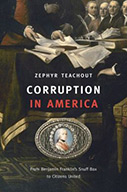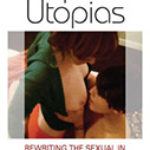Corruption in America: From Benjamin Franklin’s Snuff Boxes to Citizens United
 Author: Zephyr Teachout
Author: Zephyr Teachout
Publisher: Cambridge, MA: Harvard University Press, 2014. 384p.
Reviewer: Peter J. Henning | January 2015
Imagine a legislature in which every member (save one) was bribed to pass a law authorizing the sale of millions of acres of state-owned land for a pittance. Once that perfidy came to light, the citizenry voted out the offending legislators and installed a new crop of representatives, who promptly adopted a law revoking the prior statute and nullifying the sales. One could hardly envision a better example of democracy in action, and no finer use of legislative authority to correct an obvious wrong. Surely such corrective action to negate the stain of corruption would be upheld by courts with hardly a second thought.
And you would be wrong. In 1795, the Georgia legislature, thoroughly corrupted by land speculators, transferred 35 million acres in the vicinity of the Yazoo River in what is now Mississippi and Alabama for a bit less than two cents an acre. When the bribery of nearly every representative came to light, new members elected in their place passed a law in 1796 repealing the property grant. But before that happened, John Peck bought land that was part of the 1795 grant, and a few years later sold 13,000 acres to Robert Fletcher. Fletcher then discovered the original sale had been voided by the state law, so he sued for breach of contract to recover the $3,000 he had paid because Peck did not have good title to the land.
The Yazoo land case reached the Supreme Court, which in Fletcher v. Peck upheld the validity of the contract. Chief Justice John Marshall noted that the corruption tainting the original legislative act was “deplorable,” which would seem to be good grounds to condemn the sale. Instead, the Court invoked the Contracts Clause, which prohibits any legislative act that impairs a contract as the basis to declare the 1796 law unconstitutional – the first time the Court had struck down a state statute as violative of the federal Constitution. The Chief Justice ignored the blatant fraud behind the original land transfer because “[w]hen a law is in its nature a contract, when absolute rights have vested under that contract, a repeal of the law cannot divest those rights." Corruption may be wrong, but God forbid we offend an otherwise valid contract!
Humankind is rather susceptible to corruption, and we are almost equally adept at looking past it or explaining it away when confronted with dirty dealing. So a politician like former Illinois governor Rod Balgojevich loudly proclaimed “I have done nothing wrong” when charged with trying to sell President Obama’s Senate seat in 2008 – until he admitted guilt in 2011 as he faced years in prison.
Into this morass steps Professor Zephyr Teachout to explain how the Founding Fathers tried to keep as much corruption out of American government as possible by putting into the Constitution a string of devices to thwart efforts to feather one’s own nest. Her book, Corruption in America, moves from an extravagant parting gift to Ben Franklin from the French king to the current imbroglio over the Supreme Court’s invalidation of campaign finance statutes to allow virtually unlimited use of corporate and personal funds to sway elections. She argues that the efforts of those who wrote the Constitution have been thwarted by the five Justices comprising the majority in Citizens United, decided in 2010, that advances a narrow, formalistic understanding of what constitutes corruption. The result, in her view, allows almost anything short of naked bribery in financing campaigns, all in the name of the First Amendment’s guarantee of free speech. She laments that the decision “was not merely bad law; it was bad for politics, and displayed an even worse understanding of history.”
Professor Teachout dives into American history to look at a range of corrupt transactions, from the Yazoo land transfer to the Crédit Mobilier scandal that marred the Grant administration in the 1870s. She points out that the term lobbying was once considered disreputable at best and illegal in some states, calling them “alchemists” because they “turn money into power through the production of information and the careful use of influence.” But over time the notion of lobbying has become acceptable, even if not a virtue, and is offered up by its defenders as an example of the right of citizens to petition for redress of grievances, a hallmark of our democracy. What was once corrupt is now enshrined in the Constitution, an odd outcome for a document designed to eliminate such misuse of power.
This illustrates the theme of Corruption in America, whichis about the transformation of the notion of corruption, and the fight against it, from a broad principle to a narrower legal proscription. Professor Teachout focuses on how the prosecution of bribery has come to signify the outer limit of what can be considered corrupt under Citizens United. She unleashes a fusillade against Justice Kennedy, the majority opinion’s author, for misreading American history by diminishing what she calls the “anticorruption principle” that suffuses the thought of the Constitution’s authors. The Federalist Papers repeatedly speak of the need to prevent corruption, while a number of provisions in the country’s basic charter protect against it, even if the word never directly appears in the document. Professor Teachout’s analysis of the constitutional structure, and history of how the federal government reacted to it, makes a persuasive case that corruption is not just bribe taking, but something much more nuanced.
Whether or not one agrees with the outcome in Citizens United, its reasoning appears to be flawed. The majority’s stating point is simple: all bribes are corrupt – a proposition no one could disagree with. Where the opinion breaks down is when the majority falls for the fallacy of the undistributed middle. Here is how that works: “All A is C. All B is C. Therefore, all A is B.” The argument seems to make sense, as logic often does. Notice what Citizens United essentially says in playing out its analysis: All bribes are corrupt, all restrictions on campaign contributions are permissible if they target corruption, and therefore the restrictions are permissible only if they protect against bribery. Thus, the Supreme Court converted campaign finance law into an anti-bribery proscription, so that any restriction going beyond the type of quid pro quo arrangement prosecuted in bribery cases is likely to be problematic. The potential for massive expenditures of personal and corporate capital as an exercise of free speech is not corrupt because there is no bribe – regardless of whether the contributors buy influence with a candidate who can be expected to show a measure of gratitude for the benefits such sums can deliver.
Professor Teachout argues that the Supreme Court’s constricted interpretation of corruption paves the way for rejecting most limits on campaign spending so long as it is not tied directly to a candidate’s formal organization. But this blinks at the reality of campaign finance, and indeed the history of corruption that she describes. Bribes are a narrow, if particularly blatant, subset of corruption. The snuff box given to Ben Franklin and the shares of Crédit Mobilier dispensed to congressmen were designed to buy favor and access, a receptive ear when needed one future day. That too is corrupt, but we have now made lobbying a profession and unleashed vast pools of resources on elections that are permissible because they are not bribes.
What we get in Citizens United is the elevation of one legal principle – free speech – over the need to combat corruption by removing most of the meaning from that term. In much the same way, the constitutional protection of contracts overcame a legislature’s authority to undo a thoroughly corrupt transfer of property. Professor Teachout notes that if Thomas Jefferson were around to read Citizens United, “he would doubtless complain of its Yazooism.”
Attacking Citizens United has become the litmus test for liberals, and so we have heard calls for a constitutional amendment authorizing greater regulation of campaign contributions to protect against corporate power. Professor Teachout is a politician in addition to teaching at Fordham University’s School of Law, having run in the Democratic primary for governor of New York in 2014. But she does not fall into the trap of criticizing the case for its recognition of a corporation’s First Amendment rights, avoiding the issue of whether or not “corporations are people, my friend,” as Republican presidential candidate Mitt Romney once said so inaptly. The issue before the Court was not really about the constitutional rights of organizations but the extent of the congressional power to combat corruption.
We have seen flawed legal reasoning infect the Supreme Court on any number of occasions. Decisions like Dred Scott and Plessy v. Ferguson had a pernicious effect for years, while the celebration of economic due process in Lochner hamstrung the federal government’s efforts at economic reform until the pressure of New Deal legislation finally broke the logjam. Even Fletcher v. Peck was effectively overruled in the late nineteenth century when the Court put the power to combat corruption in the hands of the state legislatures in Illinois Central v. Illinois.
But the question is what should be done in light of Citizens United and the Court’s latest iteration of the formalistic approach to corruption, McCutcheon v. FEC, decided just before the book appeared. That case overturned limits on aggregate federal campaign contributions by individuals, with Chief Justice Roberts proclaiming that “[t]he government may no more restrict how many candidates or causes a donor may support than it may tell a newspaper how many candidates it may endorse.” That portends rough treatment for almost any restriction on campaign contributions.
Professor Teachout falls a little bit short in looking at how the Supreme Court’s analysis of corruption in Citizens United and McCutcheon should be mitigated. She writes, “To my mind, the two most important solutions that require no Supreme Court blessing are ideas advocated by Teddy Roosevelt: publicly funded elections and trust-busting.” Greater antitrust enforcement is a nice idea, but railing against big capital is little more than a reliable truism, especially when pursuing companies for monopolistic practices is unlikely to have much impact on the political system. And while public funding of campaigns is a nice idea in the abstract, in the most recent election President Obama’s own fundraising operation could far outstrip the spending limits imposed on those taking federal funds, so he went without government support for his campaign. In an era of tight budgets and heightened interest in elections from the more extreme elements in both parties, the likelihood of significant limits on spending by substituting the public purse as the source of campaign money seems quite small.
Citizens United is the law until changed by the Supreme Court, and the prospects of that occurring any time soon seem low. Perhaps Congress can use the tools of transparency to promote the anticorruption principle Professor Teachout so ably traces through American history. There is a long history of encouraging public disclosure because, as Louis Brandeis once noted so well, “sunlight is said to be the best of disinfectants.” In an age in which there is no longer a news cycle and information goes viral in the blink of an eye, perhaps the best anticorruption principle is to make public what everyone, including organizations, contributes and spends on campaigns. Hiding behind secretive political action committees or creating shells for anonymous donors should no longer be allowed.
Professor Teachout’s book is thoroughly researched and consistently interesting in its treatment of the anticorruption principle in American political and legal life. It is accessible to a broad range of readers not schooled in the intricacies of the law, and brings to life events that may be little more than a dim memory from a high school American history course. It joins Judge John Noonan’s Bribes as one of the leading treatments of the history of corruption.
Peter J. Henning – Professor of Law, Wayne State University


